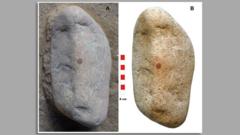Researchers in Spain have unearthed a remarkable artifact—a pebble marked with a red pigment that appears to depict a human face—along with the world's oldest complete human fingerprint. This discovery, made in the San Lázaro rock shelter in Segovia, indicates that Neanderthals might have had the capability for artistic expression, as they appear to have used the finger to paint a nose on the stone.
The find dates back approximately 43,000 years and is significant due to its arrangement, which hints at symbolic behavior linked to abstract thinking in these ancient humans. Co-author María de Andrés-Herrero from the University of Complutense in Madrid expressed excitement, stating, "It was unclear whether the dot was made with ochre, a natural clay pigment," but after extensive research, the fingerprint was confirmed, indicating it belonged to an adult male.
Though comparisons to other Neanderthal markings are lacking, archaeologist David Álvarez Alonso noted this pebble is remarkable for being the oldest painted portable item in Europe. Spanish official Gonzalo Santonja hailed the find as "the only object of portable art painted by Neanderthals."
The research also implies that Neanderthals deliberately brought the red ochre pigment to the shelter to create this mark rather than discovering it locally. This could represent a significant leap in understanding of their symbolic capacity and how they engaged with their environment artistically.
The findings have been detailed in a paper published in Archaeological and Anthropological Sciences, describing the stone as an exceptional visual symbol and a potential piece of portable art in its own right.
The find dates back approximately 43,000 years and is significant due to its arrangement, which hints at symbolic behavior linked to abstract thinking in these ancient humans. Co-author María de Andrés-Herrero from the University of Complutense in Madrid expressed excitement, stating, "It was unclear whether the dot was made with ochre, a natural clay pigment," but after extensive research, the fingerprint was confirmed, indicating it belonged to an adult male.
Though comparisons to other Neanderthal markings are lacking, archaeologist David Álvarez Alonso noted this pebble is remarkable for being the oldest painted portable item in Europe. Spanish official Gonzalo Santonja hailed the find as "the only object of portable art painted by Neanderthals."
The research also implies that Neanderthals deliberately brought the red ochre pigment to the shelter to create this mark rather than discovering it locally. This could represent a significant leap in understanding of their symbolic capacity and how they engaged with their environment artistically.
The findings have been detailed in a paper published in Archaeological and Anthropological Sciences, describing the stone as an exceptional visual symbol and a potential piece of portable art in its own right.



















